Sensor Sweep: Gas Station Knives, Ka-Zar, Wally Wood, Rooster Teeth, Drones, Poul Anderson
Monday , 11, March 2024 Sensor Sweep Leave a commentSword & Sorcery (Echoes of Crom Records): I list my top ten classic sword-and-sorcery collections by author.
Knives (Blade HQ): Put simply, gas station knives cheap out on materials. Where there should be metal, there is often plastic. Where there should a blade steel with a real name and a known composition, there is mystery-meat “Titanium-Coated Stainless” ominously labeled “China.” Their gem inlays feel as cheap as they look.
Where there should be metal, there is often plastic. Where there should a blade steel with a real name and a known composition, there is mystery-meat “Titanium-Coated Stainless” ominously labeled “China.” Their gem inlays feel as cheap as they look.
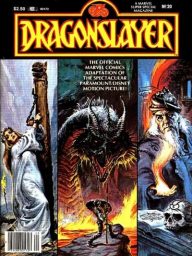 Comic Books (Dark Worlds Quarterly): The 1980s offered some new wrinkles to old dragons. One of these was the new paper quality of independent comics. Artwork could be colored with more detailed processes. Epic Illustrated was a magazine made for such artwork. Not surprising, several dragons appear there. We also have some 1970s comics that continued into the 1980s, and finally got around to dragons.
Comic Books (Dark Worlds Quarterly): The 1980s offered some new wrinkles to old dragons. One of these was the new paper quality of independent comics. Artwork could be colored with more detailed processes. Epic Illustrated was a magazine made for such artwork. Not surprising, several dragons appear there. We also have some 1970s comics that continued into the 1980s, and finally got around to dragons.
Review (Sprague de Camp Fan): I believe, Neither Beg Nor Yield, (Rogue Blades Entertainment, 2024) is the first Kickstarter funded Sword & Sorcery anthology. If not the first, it is certainly the most ambitious. When L. Sprague de Camp had his idea for the first Sword & Sorcery anthology, Swords & Sorcery, he had to query at least three different publishers before getting a contract. Nowadays S&S fandom (and technology) has grown to the point where tools like Kickstarter can garner funding for publishers and writers.
Popular Culture (Wasteland & Sky): In 2002, a TV network called G4 launched into the world, and it ended up shaping the tastes of a lot of Millennials who grew up with it. It was a cable network focused on video games, at least at first, before becoming the first geek culture hub on television. But what you don’t know is a lot of the behind the scenes weirdness involved with the network’s creation.
Art (Kairos): Akira Toriyama, the legendary creator of global phenomenon Dragon Ball, has passed away at age 68.
Dragon Ball, has passed away at age 68.
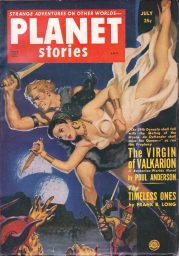 Science Fiction (John C. Wright): To recap: Science Fiction is that genre of cognitive estrangement in a post-Gothic mode, utilizing a willing suspension of disbelief, transcending anthropocentricism and temporal provincialism, where a spaceman, raygun in fist, soars through outer space with a glamorous brunette Space-Babe in his brawny arms.
Science Fiction (John C. Wright): To recap: Science Fiction is that genre of cognitive estrangement in a post-Gothic mode, utilizing a willing suspension of disbelief, transcending anthropocentricism and temporal provincialism, where a spaceman, raygun in fist, soars through outer space with a glamorous brunette Space-Babe in his brawny arms.
Comic Books (Fandom Pulse): In a tirade last year on Facebook about Mark Millar, a Scottish socialist, Mark Waid said he’d “burn the industry down” rather than share any space with those he politically disagrees with. He strawmans people like Mark Millar, Ethan Van Sciver, and others who critique the bad stories being produced by Marvel and DC Comics as “alt-right” to do so, a term not used by normal people since the media made “alt-right” meaningless in 2017.
Millar, a Scottish socialist, Mark Waid said he’d “burn the industry down” rather than share any space with those he politically disagrees with. He strawmans people like Mark Millar, Ethan Van Sciver, and others who critique the bad stories being produced by Marvel and DC Comics as “alt-right” to do so, a term not used by normal people since the media made “alt-right” meaningless in 2017.
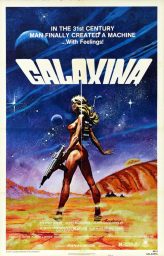 Art (Art of the Movies): Dennis and Roberts’ book The Movie Poster Art of Robert Tanenbaum, pays homage to the artist’s work and his knack for recalling a good story.
Art (Art of the Movies): Dennis and Roberts’ book The Movie Poster Art of Robert Tanenbaum, pays homage to the artist’s work and his knack for recalling a good story.
D&D (Black Gate): The Hobby Shop Dungeon, by Benoist Poire and Ernest Gary Jr. Gygax is a marvel to behold. One can utilize these books and maps for years — a complete setting loaded with maps, histories, set pieces, dungeons (arguably a mega-dungeon), wilderness, factions, heraldry, unique monsters, unique magic items, and adventure hooks abounding. It is quite a feat and an enormous labor of love.
Poire and Ernest Gary Jr. Gygax is a marvel to behold. One can utilize these books and maps for years — a complete setting loaded with maps, histories, set pieces, dungeons (arguably a mega-dungeon), wilderness, factions, heraldry, unique monsters, unique magic items, and adventure hooks abounding. It is quite a feat and an enormous labor of love.
Old Radio (The Purple Girasol): Ah, gaslighting. A favorite of old time radio. But is it really gaslighting if… well, take a listen to this 76 year old tale of Lamont, Margot and, of course, The Shadow and perhaps you’ll wake up from your own “Dream of Death“!
Science Fiction (M Porcius): In 1957, Judith Merril published, as the last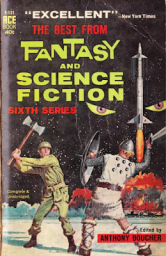 section of her anthology SF: The Year’s Greatest Science-Fiction and Fantasy: Second Annual Volume, a long alphabetical list of 1956 stories which hadn’t quite made the cut for inclusion in the anthology but which she thought worthy of recommendation.
section of her anthology SF: The Year’s Greatest Science-Fiction and Fantasy: Second Annual Volume, a long alphabetical list of 1956 stories which hadn’t quite made the cut for inclusion in the anthology but which she thought worthy of recommendation.
 Crime Fiction (Grave Tapping): The Sleeping City is a hardboiled novella-length crime tale by Marty Holland originally published in the Fall 1952 issue of Thrilling Detective. Holland, born as the very feminine Mary Hauenstein, has a knack for capturing the post-World War 2 male tough guy persona.
Crime Fiction (Grave Tapping): The Sleeping City is a hardboiled novella-length crime tale by Marty Holland originally published in the Fall 1952 issue of Thrilling Detective. Holland, born as the very feminine Mary Hauenstein, has a knack for capturing the post-World War 2 male tough guy persona.
Weird Tales (M Porcius): The October 1938 issue of Farnsworth Wright’s influential magazine Weird Tales is full of fiction by people we like here at MPorcius Fiction Log. We’ve already read the Manly Wade Wellman story in the issue, “Up Under the Roof.”
Pulp (Vintage Pop Fiction): The Festival of the Dead is a collection of the early Jimmy Wentworth stories by Sidney Herschel Small (1893-1958), published in pulp magazines in 1931. The stories are set in San Francisco’s Chinatown. Jimmy Wentworth is an American but was brought up in China and speaks fluent Chinese.
Wentworth stories by Sidney Herschel Small (1893-1958), published in pulp magazines in 1931. The stories are set in San Francisco’s Chinatown. Jimmy Wentworth is an American but was brought up in China and speaks fluent Chinese.
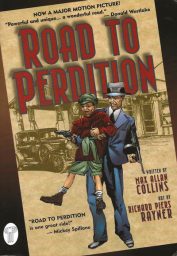 Comic Books (Rip Jagger Dojo): Road to Perdition is a fantastic read. This period crime drama is famous because they made a movie out of it. (More on that in a few moments.) But the original story was produced as part of DC’s experimental Paradox Mystery imprint which was used to tell grittier stories in a format more akin to Japanese Manga in size.
Comic Books (Rip Jagger Dojo): Road to Perdition is a fantastic read. This period crime drama is famous because they made a movie out of it. (More on that in a few moments.) But the original story was produced as part of DC’s experimental Paradox Mystery imprint which was used to tell grittier stories in a format more akin to Japanese Manga in size.
Tarzan (ERB Podcast): Tim, Scott and Jess discuss Will Murray’s excellent new novel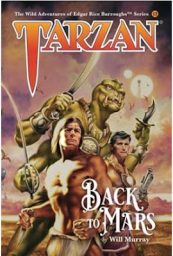 “Tarzan: Back to Mars,” in which the Lord of the Jungle returns to Barsoom to head off an invasion of Earth.
“Tarzan: Back to Mars,” in which the Lord of the Jungle returns to Barsoom to head off an invasion of Earth.
Science Fiction (Black Gate): Mike McQuay published his first SF novel, Lifekeeper, in 1980, and he died just fifteen years later, in May 1995. But in that decade and a half he enjoyed an impressive career as a science fiction and fantasy novelist. He made his mark writing men’s adventure with a light SF twist, starting with the Mathew Swain (“The 21st Century Private Eye”) series.
 Comic Books (Cyborg Caveman): A larger square-bound edition of reprint material repackaged as a Ka-Zar comic, this is actually composed of guest appearances from other titles such as Spider-Man and Daredevil. Even in the early days from his first Silver Age appearance in X-Men #10 and onward, Ka-Zar was a reliably solid guest star.
Comic Books (Cyborg Caveman): A larger square-bound edition of reprint material repackaged as a Ka-Zar comic, this is actually composed of guest appearances from other titles such as Spider-Man and Daredevil. Even in the early days from his first Silver Age appearance in X-Men #10 and onward, Ka-Zar was a reliably solid guest star.
Art (DMR Books): Over at the official Norm Saunders website there is an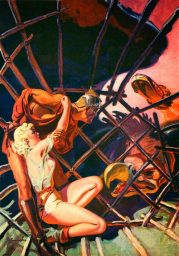 excellent career chronology as well as a very cool memoir of his father by David Saunders. There’s no way I can top those two resources, so simply click on the hyperlinks above to learn about Norman, his exceptional parents and the very full life he led.Review (Nerdrotic): Dune: Part Two Movie Review – Spoiler Free
excellent career chronology as well as a very cool memoir of his father by David Saunders. There’s no way I can top those two resources, so simply click on the hyperlinks above to learn about Norman, his exceptional parents and the very full life he led.Review (Nerdrotic): Dune: Part Two Movie Review – Spoiler Free
Anime (Kairos): Earlier reports of geek culture cartoon studio Rooster Teeth Productions’ demise turned out to have been premature. But now, the Time-Warner subsidiary’s general manager has issued a statement confirming that the animation company has indeed given up the ghost.
Games (Future War Stories): Here we are my brothers and sisters of FWS: the end of the Forgotten MSF Video Games Top 10 lists. It has been years on this journey. For the last of this series of Top 10s, we have some interesting picks that span all of the gaming generations and some that I played and some I did not…but wanted to. As we close out this series, I am left with a feeling of what will appear on lists like this in the future.
the end of the Forgotten MSF Video Games Top 10 lists. It has been years on this journey. For the last of this series of Top 10s, we have some interesting picks that span all of the gaming generations and some that I played and some I did not…but wanted to. As we close out this series, I am left with a feeling of what will appear on lists like this in the future.
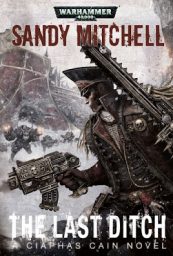 Warhammer (Wert Zone): Commissar Ciaphas Cain and the Valhallan 597th are deployed to Nusquam Fundumentibus to deal with an incursion of orks. The campaign promises to be standard, although still dangerous, until Cain learns of a far greater threat lurking on the planet, one which sees both the humans and orks as enemies.
Warhammer (Wert Zone): Commissar Ciaphas Cain and the Valhallan 597th are deployed to Nusquam Fundumentibus to deal with an incursion of orks. The campaign promises to be standard, although still dangerous, until Cain learns of a far greater threat lurking on the planet, one which sees both the humans and orks as enemies.
Interview (DMR Books): I have employed no strategy whatsoever yet. Die By the Sword Volume II will mark the first time I am published, and so only time will tell what I might do to get my name out there. Of course, social media appears to be the foremost way to spread knowledge about oneself, so that will factor into any plan I conceive.
RPG (Isegoria): Interactive books weren’t a completely new idea before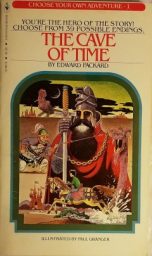 Choose Your Own Adventure (CYOA), but they weren’t popular: There was a romance novel from the 1930s, where the reader decides which suitor the protagonist marries with dozens of possible endings.
Choose Your Own Adventure (CYOA), but they weren’t popular: There was a romance novel from the 1930s, where the reader decides which suitor the protagonist marries with dozens of possible endings.
RPG (MSN): Many mediums have explored Lovecraftian motifs to great effect, and video games are no exception here. There are several genres in gaming that have toyed around with Lovecraft’s ideas, and the popular role-playing genre has played a major role in this department. As one might expect, the best Lovecraftian RPGs are well worth checking out.
Antiquarian (Swords Lore): At risk of stereotyping, I’ve decided to dedicate Senchas Claideb posts during the month of March to Ireland or all topics Irish. Unlike standard St. Patty’s Day lip service, I’ll be providing lore on topics such as the Gaelic language, the old, primeval gods of the Isle, and other lesser-known anecdotes about the history, mythology, and people of Ireland.
Cinema (Fantasy Literature): I watched another film about Quetzalcoatl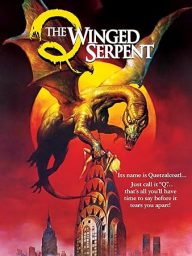 being alive and well in modern-day America, Larry Cohen’s Q (1982), a picture that is infinitely superior to the earlier film in every aspect of the cinematic arts. In this consistently amusing picture, Michael Moriarty stars as another Q, Quinn, a small-time crook, ex-junkie, two-time ex-con and aspiring musician, who discovers the serpent bird’s nesting lair way up in the tower of the Chrysler Building.
being alive and well in modern-day America, Larry Cohen’s Q (1982), a picture that is infinitely superior to the earlier film in every aspect of the cinematic arts. In this consistently amusing picture, Michael Moriarty stars as another Q, Quinn, a small-time crook, ex-junkie, two-time ex-con and aspiring musician, who discovers the serpent bird’s nesting lair way up in the tower of the Chrysler Building.
Artist (Cartoonist Kayfabe): Wally Wood 1927-1981 – An Extraordinary Comic Book Artist.
Fiction (Adventures Fantastic): Marvin Kaye (1938=2021) was born on this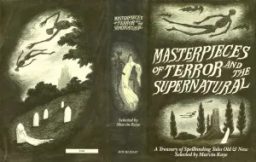 date, March 10. In observance, I’m going to look at some (but not all) of his anthologies. I’ll not be discussing his tenure as editor of H. P. Lovecraft’s Magazine of Horror or Weird Tales. I’m furthermore going to limit most of my remarks to mostly the anthologies that had Science Fiction Book Club editions in the 1980s and 1990s.
date, March 10. In observance, I’m going to look at some (but not all) of his anthologies. I’ll not be discussing his tenure as editor of H. P. Lovecraft’s Magazine of Horror or Weird Tales. I’m furthermore going to limit most of my remarks to mostly the anthologies that had Science Fiction Book Club editions in the 1980s and 1990s.
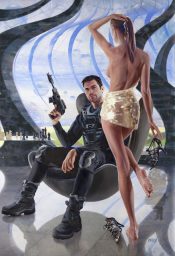 Science Fiction (Poul Anderson Contributor Articles): The Technic civilization stories are not hard military sf in the style of for example David Drake. Nonetheless, Poul Anderson took some care regarding the kinds of weaponry his heroes and their foes would use. There are auto-guided missiles, most carrying nuclear warheads. There are energy weapons, so called “Blasters” which are not lasers – note how Technic “blaster cannon” are contrasted with more primitive Merseian lasers in a one-sided confrontation in THE DAY OF BURNING.
Science Fiction (Poul Anderson Contributor Articles): The Technic civilization stories are not hard military sf in the style of for example David Drake. Nonetheless, Poul Anderson took some care regarding the kinds of weaponry his heroes and their foes would use. There are auto-guided missiles, most carrying nuclear warheads. There are energy weapons, so called “Blasters” which are not lasers – note how Technic “blaster cannon” are contrasted with more primitive Merseian lasers in a one-sided confrontation in THE DAY OF BURNING.
Military (Isegoria): Early Predator losses were high, David Hambling notes (in Swarm Troopers), but acceptable: By 2001, twenty of the sixty Predators had been lost to a mixture of pilot error, bad weather, accidents, and enemy fire.
(in Swarm Troopers), but acceptable: By 2001, twenty of the sixty Predators had been lost to a mixture of pilot error, bad weather, accidents, and enemy fire.
History (Men of the West): Marcus Aurelius, Alfred, and St. Louis, are the three examples of perfect virtue on a throne. But the virtue of St. Louis is deeply tainted with asceticism; and with the sublimated selfishness on which asceticism is founded, he sacrifices everything and everybody—sacrifices national interests, sacrifices the lives of the thousands of his subjects whom he drags with him in his chimerical crusades.
Please give us your valuable comment